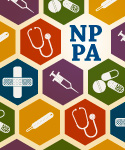January 13th, 2016
Off to the Races — Maximizing the PA Role to Fill Healthcare Gaps
Charity Maniates, MSPA, MPH, PA-C
What do you want to be when you grow up? It’s a question we hear from childhood, innocent but underscored with pressure to have a life plan by the age of 18. Realistically, it’s a journey of many experiences, successes and failures that lead individuals to gratifying careers. My first career choice as a 10-year-old girl was to be a horse jockey with daydreams of winning the Triple Crown. I’ll admit that my obsession with reading horse books, along with my sense of adventure, was the likely underpinning for that. While working as a baker, home health aide, and recycling coordinator while I was in college, I saw medicine as a world of marvel and intrigue. I read the The Hot Zone and Mountains Beyond Mountains and was smitten by the drama of the television series ER. But I didn’t want to be a doctor or a nurse and I had never heard of a physician assistant.
 Eventually, my path lead me to train as a physician assistant, currently touted as one of the top 10 promising career choices by Forbes, Time, and The New York Times. That’s quite an accolade for a fairly young medical career (the first graduating class was in 1960). Yes, job growth, salary, position availability, and training are usually the major factors in these ratings, but there’s more to it than that. Entrance into PA school is competitive and selective; applicants must have diversity of experience and well-developed communication skills and must demonstrate strong teamwork and resilience. PA training is generalized, providing exposure to many areas of medicine, underscoring the versatility and lateral movement of the PA role. Growing voids in primary care both in underserved urban and rural communities are requiring many PAs and NPs to fill the PCP role, maximizing our scope of practice. PAs are first assists in surgery and integrated in acute, subacute and general medicine in outpatient and inpatient settings. In a primary care setting, PAs can accomplish 85% of a physician’s workload at one-half the salary. And of course, the cost of graduate education is significantly less than going to medical school. Utilizing PAs is a cost-saving approach to increasing access to care, reducing hospitalizations, and improving the quality of healthcare. No wonder there has been an exponential growth of PAs in the last five years. We are needed desperately.
Eventually, my path lead me to train as a physician assistant, currently touted as one of the top 10 promising career choices by Forbes, Time, and The New York Times. That’s quite an accolade for a fairly young medical career (the first graduating class was in 1960). Yes, job growth, salary, position availability, and training are usually the major factors in these ratings, but there’s more to it than that. Entrance into PA school is competitive and selective; applicants must have diversity of experience and well-developed communication skills and must demonstrate strong teamwork and resilience. PA training is generalized, providing exposure to many areas of medicine, underscoring the versatility and lateral movement of the PA role. Growing voids in primary care both in underserved urban and rural communities are requiring many PAs and NPs to fill the PCP role, maximizing our scope of practice. PAs are first assists in surgery and integrated in acute, subacute and general medicine in outpatient and inpatient settings. In a primary care setting, PAs can accomplish 85% of a physician’s workload at one-half the salary. And of course, the cost of graduate education is significantly less than going to medical school. Utilizing PAs is a cost-saving approach to increasing access to care, reducing hospitalizations, and improving the quality of healthcare. No wonder there has been an exponential growth of PAs in the last five years. We are needed desperately.
If you are a physician assistant, you know all of this. Our training mirrors the medical model to enhance our collaborative role with physicians. Now that I am a practicing provider in subacute and longterm care, I appreciate the effectiveness of team-based patient care. With the passage of the Affordable Care Act, PAs have been elevated in the national spotlight as the key solution to meeting primary care shortages. This can also extend to primary care needs in the longterm care setting as well. Although it’s an undertaking, PAs have been trained to meet the challenge, but dysfunctional systems need to be improved to ensure success. With the development of medical home models and emphasis on team-centered healthcare, hopefully PAs and NPs embracing the PCP role will be less burdened. Yet, antiquated state and federal restrictions still exist that limit PAs’ scope of practice in prescribing specific medications, ordering home health services, and providing hospice referrals. In addition, Medicare reimbursement rates are lower for PAs providing the same level of care of physicians. This seems counterproductive and clashes with the expectation of healthcare reform. Since PAs are able to provide a level of primary care that is on par with physicians, the misconception that a PA is merely a “helper” is severely outdated. It’s essential that PAs practice at full capacity of our licensing to ensure quality patient care and meet the healthcare needs in our communities.
I didn’t know as a girl that I would stumble upon a career that is almost as exciting as racing horses on Churchill Downs. I’m content to relive that girlhood dream on television every year, while the real action happens day to day caring for patients.




I had a full career in Family Medicine. I went to medical school at the U of Colorado where Henry Kemp & Henry Silver were the nationally known experts in pediatric innovation. They trained the first civilian “super nurses” as we called them. They were the first independently practicing nurses. I have been associated with many during my mandatory military time and since. They are best used in specialties, but do not have, and cannot possibly have the background, to do general primary care.
Physicians are an essential component of medical care. However, the reliance on physicians as the sole provider able to diagnose, treat and manage disease has changed. PAs have been trained as generalists to diagnose and treat acute and chronic diseases in primary care and rotate through specialties just like medical students. Healthcare has changed drastically in just 50 years. Innovation within our systems, including provider roles, is essential to provide quality care, avoid burnout and continue to provide primary care to our underserved and vulnerable populations.
There are 60,000 PAs that would disagree with Dr Cricton. PAs are trained for all the major disciplines, and move quickly in any direction their clinical role demands. We are trained and certified, licensed to assess, treat and prescribe medications. Certainly many PAs go on to practice in a specialty area, like many(or most!) physicians. Having practiced for over 30 years in Primary Care in a city neighborhood health center, and having recruited and mentored over 50 NPs and PAs, our patients would not have the access to high quality primary care they so desperately need. If my NP and PA colleagues couldn’t fill the role, there are not enough physicians to provide the care. . Our Health Center has over 1,000 employees, over 100,000 patient visits per year. Where, I might ask, would we be able to provide NEW patient visits the SAME DAY they register, if PAs and NPs couldn’t practice primary care?
We are a Gold Certified Medical Home. That wouldn’t be possible without the high quality primary care our physicians AND NP/PAs provide. The government would shut us down.
Only when YOU can’t “see the doctor” or Congress men and women “can’t see the doctor” will backward looking providers and government fully recognize the high quality care and access PAs provide and which our citizens deserve and expect.
Cathy, thank you for your work as a PA-C in primary care. You emphasize that a medical home model approach is team based and is not reliant on one type of provider. The effective work of PAs/NPs, along with physicians, has allowed for increased access to care in the community. We must appreciate and utilize the strengths of each provider role moving forward to continue meeting the daunting task providing equitable healthcare.